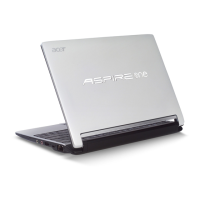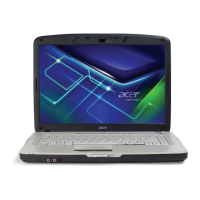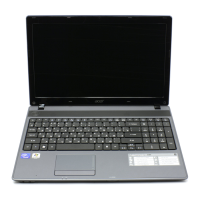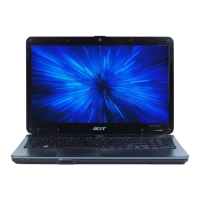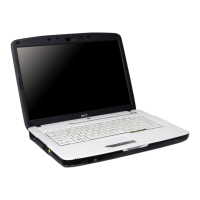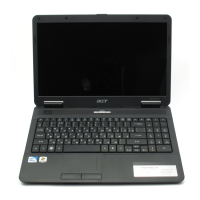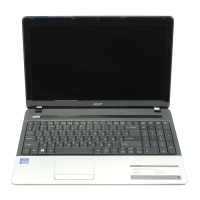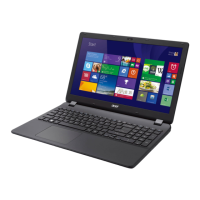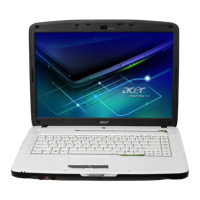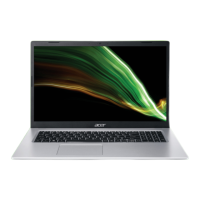Do you have a question about the Acer Aspire 5350 and is the answer not in the manual?
Summary of the computer's main features.
Details on the computer's processor and chipset.
Specifications for system memory (RAM) and supported configurations.
Information about the notebook's display specifications.
Details on graphics controller and supported resolutions.
Description of all input/output ports available on the system.
Information on special keyboard keys and controls.
List of pre-installed software applications.
Overview of the notebook's physical layout and components.
Detailed technical specifications presented in table format.
Detailed specifications for the CPU, including speed, cores, and cache.
Information regarding the system's BIOS vendor, version, and features.
Overview of the BIOS Setup Utility for hardware configuration.
Guide to navigating the BIOS setup menus and options.
Displays a summary of the computer's hardware information.
Parameters for safeguarding and protecting the computer.
Procedure for setting Supervisor and User passwords.
Allows changes to the order of boot devices.
Utilities for updating the system BIOS Flash ROM.
Details about removing HDD/BIOS passwords.
Steps to clear User or Supervisor BIOS passwords.
Allows changing the boot device without accessing BIOS.
Tool to copy BIOS information to EEPROM for hardware management.
Chapter introduction to general information and procedures.
List of tools required for notebook maintenance.
Graphic representation of module removal and installation sequences.
Initial steps and prerequisites for performing maintenance.
Procedure to remove the notebook's battery pack.
Steps to remove the hard disk drive module.
Procedure for removing memory modules.
Steps to remove the keyboard from the notebook.
Procedure to remove the upper cover of the notebook.
Detailed steps for removing the mainboard.
Procedure for removing the thermal module.
Steps for removing the Central Processing Unit (CPU).
Procedure for removing the LCD panel.
Introduction to troubleshooting common notebook problems.
General guidance for troubleshooting computer problems.
Steps to resolve issues where the system does not power on.
Troubleshooting steps for display-related problems.
Specific troubleshooting steps for LCD failures.
Steps to diagnose and resolve keyboard issues.
Troubleshooting steps for internal speaker problems.
Steps to diagnose and resolve microphone issues.
Troubleshooting guide for USB port failures.
Steps to resolve issues with wireless network functionality.
Troubleshooting for Bluetooth connectivity problems.
Steps to diagnose and resolve card reader issues.
Troubleshooting steps for thermal unit and fan problems.
Troubleshooting for Optical Disc Drive (ODD) issues.
Guidance for diagnosing intermittent system hangs.
Description of POST codes during system startup.
Location of jumpers and connectors on the mainboard.
Location of jumpers and connectors on the USB board.
Layout of switches and connectors on the power board.
Location of connectors on the card reader.
Procedure for clearing BIOS passwords and recovering BIOS.
Steps to clear BIOS Password (Supervisor and User).
Procedure for BIOS recovery using a crisis disk.
Visual breakdown of the computer's main assemblies.
Exploded diagram of the main computer assembly.
Exploded diagram of the LCD module assembly.
Exploded diagram of the upper cover components.
Exploded diagram of the lower cover components.
List of all Field Replaceable Units with part numbers.
List of screws used in the assembly and disassembly.
Model definition and configuration for Aspire 5750.
Model definition and configuration for Aspire 5750G.
List of components tested with Windows 7 environment.
Compatibility details for Aspire 5750/5750G models.
Overview of online technical support services and resources.
| Processor | Intel Core i3-2350M |
|---|---|
| Storage | 500 GB HDD |
| Display | 15.6" HD (1366 x 768) LED-backlit TFT LCD |
| Graphics | Intel HD Graphics |
| Operating System | Windows 7 Home Premium |
| Battery | 6-cell Li-ion |
| Weight | 2.6 kg |
